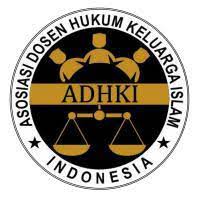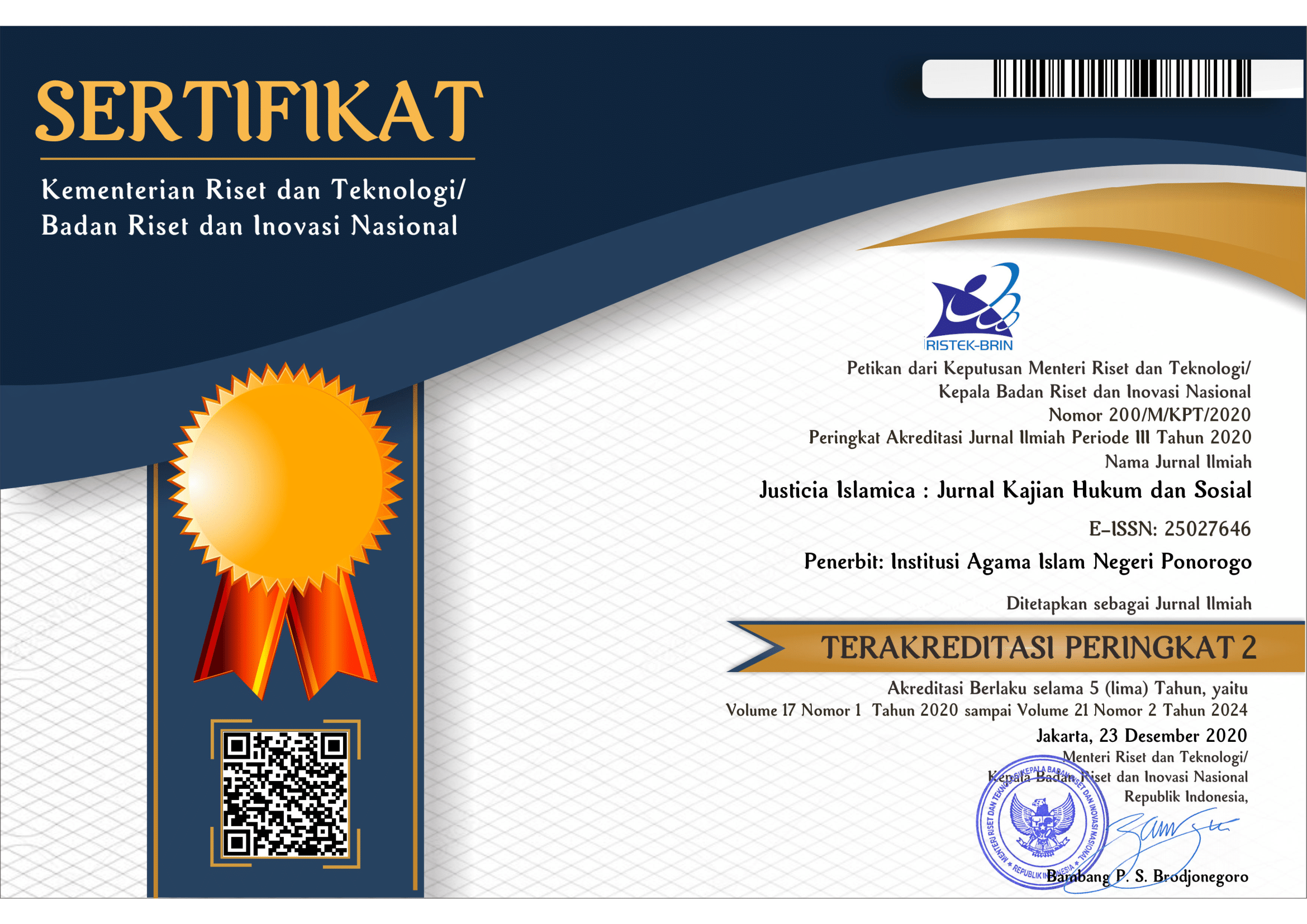Reassessing Tajdid al-Nikah
Maqasid al-Shariah and Legal Status of Illegitimate Children in Central Lombok
DOI:
https://doi.org/10.21154/justicia.v22i1.7343Abstract
The practice of tajdid al-nikah (renewal of marriage) within the framework of Maqhasid Sharia presents significant issues in Islamic law, particularly concerning legitimizing the lineage (nasab) of children born outside of marriage. In Islamic law, a couple involved in adultery can validate their relationship post-birth of a child through tajdid al-nikah to establish legal paternity. Although this practice aims to fulfill maqasid al-shariah objectives, such as preserving religion and lineage, it introduces various social, ethical, and legal challenges. This study aims to evaluate the social, moral, and legal ramifications of tajdid al-nikah and assess its alignment with the core principles of maqasid al-shariah, namely, the preservation of religion, lineage, intellect, and property. Additionally, it examines local perceptions in Central Lombok regarding tajdid al-nikah and the Islamic understanding of children born outside of marriage. The research employs a combination of literature review, field investigations, document analysis, and interviews with Islamic law experts and local religious leaders, using an analytical descriptive method grounded in Islamic legal principles. The findings reveal the complexities associated with tajdid al-nikah. While the practice supports maqasid al-shariah goals such as preserving lineage and religion, issues such as the ambiguity in confirming legitimate lineage and potential social repercussions highlight the need for further study. This research advocates for continued exploration and discussion on how tajdid al-nikah can be effectively integrated within an Islamic legal framework that respects maqasid al-shariah values, justice, legal certainty, and social welfare.
References
Agatha, Georgina. “Pembuktian Dan Pengesahan Anak Luar Kawin Serta Akibat Hukumnya Setelah Berlaku Putusan Mahkamah Konstitusi Nomor 46/PUU-VIII/2010 Dalam Pandangan Hukum Islam.” Indonesian Notary 3, no. 1 (2021): 23.
Ahmad, Awang Nib Zuhairi Bin Awang, Hadenan Bin Towpek, and Abdul Razak Bin Abdul Kadir. “Kesejahteraan Keluarga Menurut Maqasid Syariah Dalam Konteks Masyarakat Majmuk Di Sarawak: Satu Tinjauan Awal.” Azka International Journal of Zakat & Social Finance, 2021, 163–85.
Ali, Zainuddin. “Hukum Perdata Islam Di Indonesia.” (No Title), 2007. https://cir.nii.ac.jp/crid/1130000796716938880.
“Al-Qur’an Dan Terjemahannya,” 2024.
Alyana, Anisa Putri, and Ramdan Fawzi. “Pandangan Tokoh Agama Terkait Tajdidun Nikah Bagi Wanita Hamil Di Luar Nikah.” Jurnal Riset Hukum Keluarga Islam, 2022, 89–94.
Anwar, Shabri Shaleh. “Tanggung Jawab Pendidikan Dalam Perspektif Psikologi Agama.” Psympathic: Jurnal Ilmiah Psikologi 1, no. 1 (2014): 11–21.
Ariadi, Lalu Muhammad. “Islam Sasak: Sebuah Manifestasi Fikih-Budaya.” Schemata: Jurnal Pasca Sarjana IAIN Mataram 6, no. 2 (2017): 155–66.
Asyhadie, Zaeni, and Arief Rahman. “Pengantar Ilmu Hukum.” Raja Grafindo Persada, Jakarta, 2013.
Auda, Jasser. Maqasid Al-Shariah: A Beginner’s Guide. Vol. 14. International Institute of Islamic
Fauzi, Fahrul. “Tinjauan Kawin Hamil Dalam Perspektif Hukum Islam.” Journal of Islamic Law Studies 3, no. 2 (2021): 7.
Hadi, Mukhammad Nur. Pernikahan Dan Disabilitas: Nalar Hukum Penghulu Di Kota Malang. Publica Institute Jakarta (2020).
Hanafi, Miftahuddin Yusuf, and Ahmad Hafid Safrudin. “Analisis Hukum Islam Terhadap Tradisi Tajdid Al-Nikah Di Desa Kampungbaru Kecamatan Kepung Kabupaten Kediri.” Salimiya: Jurnal Studi Ilmu Keagamaan Islam 1, no. 2 (2020): 212–29.
Hasunah, Umi, and Susanto Susanto. “Iddah Perempuan Hamil Karena Zina Dalam Kompilasi Hukum Islam Pasal 53.” Jurnal Hukum Keluarga Islam 1, no. 1 (2016): 99–114.
Hidayatulloh, Haris, and Siti Lailatul Munawaroh. “Pandangan Tokoh Masyarakat Terhadap Hukum Perkawinan Wanita Hamil (Studi Kasus Di Kecamatan Pangarengan Kabupaten Sampang).” Jurnal Hukum Keluarga Islam 2, no. 1 (2017): 1–20.
Jauhar, Ahmad Al-Mursi Husain. “Maashid Syariah” 2018 (n.d.): 131.
Khairani, Khairani, and Cut Nanda Maya Sari. “Pengulangan Nikah Menurut Perspektif Hukum Islam (Studi Kasus Di KUA Kecamatan Kota Kualasimpang).” Samarah: Jurnal Hukum Keluarga Dan Hukum Islam 1, no. 2 (2017): 397–415.
Khakim, M. Lutfi, and Mukhlis Ardiyanto. “Menjaga Kehormatan Sebagai Perlindungan Nasab Perspektif Maqashid Syari’ah.” Nizham: Jurnal Studi Keislaman 8, no. 01 (2020): 32–41.
KHI, F. I. D. “Hukum Pernikahan Wanita Hamil Akibat Zina Menurut Fikih Islam DAN HKI.” Skripsi, Universitas Muhammadiyah Makassar, 2021.
Khumairoh, Azizatul. “Tinjauan Maqashid Syariah Terhadap Kehidupan Istri Pasca Perceraian Pernikahan Sirri (Studi Kasus Di Desa Jleper Kecamatan Mijen Kabupaten Demak).” PhD Thesis, Iain Kudus, 2022. http://repository.iainkudus.ac.id/7047/.
Kuhlken, Julie. “Heidegger and Aristotle: Action, Production, and Ethos.” The Journal of Speculative Philosophy 28, no. 3 (2014): 370–79.
Ma’mun, Sukron. “Tradisi Nganyari Akad Nikah Pada Masyarakat Jengglong Di Boyolali.” Al-Ahwal: Jurnal Hukum Keluarga Islam 12, no. 2 (2019): 198–207.
Manan, Abdul. “Reformasi Hukum Islam Di Indonesia.” (No Title), 2006. https://cir.nii.ac.jp/crid/1130000795730484224.
Marwa, Muhammad Habibi Miftakhul, and Norma Sari. “Akad Nikah Virtual Perawat Saat Covid-19: Tinjauan Hukum Perkawinan Islam Dan Hukum Kesehatan.” Jurnal Hukum Ius Quia Iustum 29, no. 3 (2022): 674–97.
Memed, Humaedillah. “Status Hukum Akad Nikah Wanita Hamil Dan Anaknya.” Gema Insani Perss, 2002.
Meri, Oktafiani. “Pandangan Ulama Muhammadiyah Dan Nahdatul Ulama Tentang Larangan Melangsungkan Pernikahan Pada Hari Meninggal Orang Tua (Studi Desa Margo Dadi Kecamatan Tumijajar Kabupaten Tulang Bawang Barat).” PhD Thesis, UIN RADEN INTAN LAMPUNG, 2023. http://repository.radenintan.ac.id/23313/.
Millah, Saiful, and Asep Saepudin Jahar. Dualisme Hukum Perkawinan Islam Di Indonesia: Fiqh Dan KHI. Vol. 253. Amzah (Bumi Aksara), 2021. https://books.google.com/books?.
Nasution, Khoiruddin. “Penerapan Kompilasi Hukum Islam Pasal 53 Tentang Kawin Hamil Dan Tajdid Al-Nikah Di Kecamatan Mlati Dalam Tinjauan Maqasid Syariah.” Jurnal Millah 20 (2021). https://www.academia.edu/download/106396821/16513-Article_Text-44949-49346-10-20210424.pdf_filename_UTF-816513-Article_Text-44949-49346-10-20210424.pdf.
Nur, Zulfahmi. “Keadilan Dan Kepastian Hukum (Refleksi Kajian Filsafat Hukum Dalam Pemikiran Hukum Imam Syâtibî).” Misykat Al-Anwar Jurnal Kajian Islam Dan Masyarakat 6, no. 2 (2023): 247–72.
Oakley, Ann. “A Case of Maternity: Paradigms of Women as Maternity Cases.” In The Medicalization of Obstetrics, 209–33. Routledge, 2021. https://www.taylorfrancis.com/chapters/edit/10.4324/9781003249603-16/case-maternity-paradigms-women-maternity-cases-ann-oakley.
Radbruch, Gustav. “Law’s Image of the Human: A Translation of Gustav Radbruch’s 1926 Inaugural Lecture at Heidelberg University with an Introductory Foreword.” Oxford Journal of Legal Studies 40, no. 4 (2020). https://philpapers.org/rec/RADLIO.
Ratnasari, S. “Tajdidun Nikah Pasangan Suami Istri Perspekti Hukun Islam (Studi Kasus Di Desa Purwoasri Kecamatan Gumukmas Jember).” Doctoral Dissertation, Universitas Islam Negeri Kiai Haji Achmad Siddiq Jember, 2018.
Rofi’ah, Ummu, and Wakid Evendi. “Tajdidun Nikah Sebagai Upaya Penguatan Keluarga Sakinah (Studi Kasus Di Desa Rejoagung Kecamatan Ngoro Kabupaten Jombang).” Birokrasi: JURNAL ILMU HUKUM DAN TATA NEGARA 1, no. 3 (2023): 276–97.
Sahibuddin, M. Sahibudin M. “Pandangan Fuqha’Terhadap Tajdid An-Nikah (Sebuah Ekplorasi Terhadap Fenomena Tajdid an-Nikah DI Desa Toket Kec. Proppo Kab. Pamekasan).” Al-Ulum Jurnal Pemikiran Dan Penelitian Ke Islaman 5, no. 2 (2018): 76–83.
Saifullah, Khasan. “Implikasi Tajdid Al-Nikah Terhadap Relasi Suami Istri Dalam Membina Keluarga (Studi Kasus Desa Ngampal Kecamatan Sumberrejo Kabupaten Bojonegoro).” PhD Thesis, IAIN PONOROGO, 2018. http://etheses.iainponorogo.ac.id/4849/1/PERPUS.pdf.
Siti. “Wawancara.” Lombok Tengah, 2023.
Soekanto, Soerjono. “Faktor-Faktor Yang Mempengaruhi Penegakan Hukum,” 2011. http://library.stik-ptik.ac.id/detail?id=44965&lokasi=lokal.
Solihin, Khabib, Siti Nur Ami’in, and Puji Lestari. “Maqashid Shariah Sebagai Alat Ukur Kinerja Bank Syariah Telaah Konsep Maqasid Sharia Index (MSI) Asy-Syatibi.” Laa Maisyir: Jurnal Ekonomi Islam 6, no. 2 (2019): 148–70.
Stigler, George J. “The Development of Utility Theory. II.” Journal of Political Economy 58, no. 5 (October 1950): 373–96. https://doi.org/10.1086/256980.
Wahid, Wawan Gunawan Abdul. “Pandangan Majlis Tarjih Dan Tajdid Muhammadiyah Tentang Nikah Sirri Dan Itsbat Nikah: Analisis Maqashid Asy-Yari’Ah.” MusâWa Jurnal Studi Gender Dan Islam 12, no. 2 (2013): 215–36.
Wati, F. “Pembaruan Hukum Perkawinan Islam Di Indonesia.” Doctoral Dissertation, IAIN Jember, 2020.
Zaid ad-Din al-Malibari, I’anah at-Talibin. “Zaid Ad-Din al-Malibari, I’anah at-Talibin.” Mesir : Dar Ihya al-Kutub al-‘Arabiyah, t.t, n.d., 35.
Zaini, Achmad Mujab. “Tinjauan Hukum Terhadap Nyar-Nganyre Kabhin Masyarakat Pamekasan.” B.S. thesis, Fakultas Syariah dan Hukum UIN Syarif Hidayatullah Jakarta, 2018. https://repository.uinjkt.ac.id/dspace/handle/123456789/44671.
Downloads
Published
Issue
Section
License
Copyright (c) 2024 Doni Azhari

This work is licensed under a Creative Commons Attribution-ShareAlike 4.0 International License.
Requirements to be met by the author as follows:
- Author storing copyright and grant the journal right of first publication manuscripts simultaneously with licensed under the CC BY-SA allows others to share the work with a statement of the work's authorship and initial publication in this journal.
Authors can enter into the preparation of additional contractual separately for the non-exclusive distribution of a decadent version of the journal issue (e.g., post it to an institutional repository or publish it in a book), with the recognition of initial publication in this journal.
Authors are allowed and encouraged to post their work online (e.g., in institutional repositories or on their website) before and during the submission process because it can lead to productive exchanges and citations earlier and more severe than published works. (see The Effect of Open Access).
This work is licensed under CC BY-SA.


















